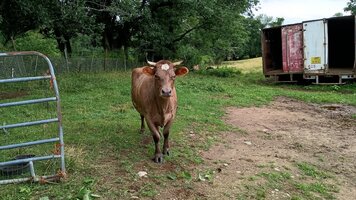RockyRidgeFarmRI
Just born
- Joined
- Jul 13, 2024
- Messages
- 2
- Reaction score
- 6
- Points
- 4
Hello,
I have a few questions about buying a cow for slaughter.
I have a local farmer selling a cow raised on organic grass only that's a little over 3 years old. It's a Scottish highland mixed with a hereford. The cost is $1200, farmer claims it's about 1400lbs, and he thinks hang weight would be around 650-700 lbs. I think his weight estimate might be high. My plan is to rent a trailer, pick up the cow and drive it to the slaughter house. I am splitting this with my dad who has also never done this before. His heard size is 5 right now, he has sold a few this year after they calved out. This cow I'm buying just had her calf a few months ago, he sold the calf already. This is the last cow he has available this year, and i placed a deposit on the cow. I plan to bring it to processor in about a week.
Questions:
Is this old for a cow of this breed for processing ?
How does this age effect taste and tenderness in this case ? Farmer says steak won't be tough, and it's a fine age for slaughter.
Are there certain cuts that I should get ground up instead of cut because they maybe wouldn't be tender enough?
Does the cow in the photo look like it would hang at 650-700lbs?
Recommended hang time ?
Final question, I am packaging myself at slaughterhouse, should I do butcher paper, vac seal or papered then vac sealed ? Hoping it lasts 3 years at most, probably 1-2 years.
Thanks in advance
I have a few questions about buying a cow for slaughter.
I have a local farmer selling a cow raised on organic grass only that's a little over 3 years old. It's a Scottish highland mixed with a hereford. The cost is $1200, farmer claims it's about 1400lbs, and he thinks hang weight would be around 650-700 lbs. I think his weight estimate might be high. My plan is to rent a trailer, pick up the cow and drive it to the slaughter house. I am splitting this with my dad who has also never done this before. His heard size is 5 right now, he has sold a few this year after they calved out. This cow I'm buying just had her calf a few months ago, he sold the calf already. This is the last cow he has available this year, and i placed a deposit on the cow. I plan to bring it to processor in about a week.
Questions:
Is this old for a cow of this breed for processing ?
How does this age effect taste and tenderness in this case ? Farmer says steak won't be tough, and it's a fine age for slaughter.
Are there certain cuts that I should get ground up instead of cut because they maybe wouldn't be tender enough?
Does the cow in the photo look like it would hang at 650-700lbs?
Recommended hang time ?
Final question, I am packaging myself at slaughterhouse, should I do butcher paper, vac seal or papered then vac sealed ? Hoping it lasts 3 years at most, probably 1-2 years.
Thanks in advance
Attachments
Last edited:


